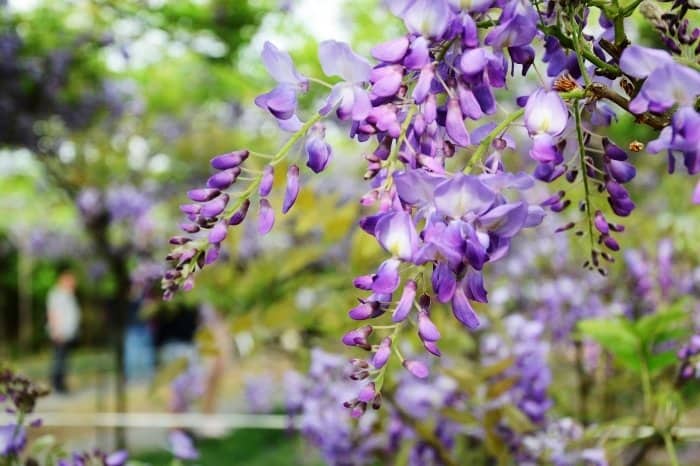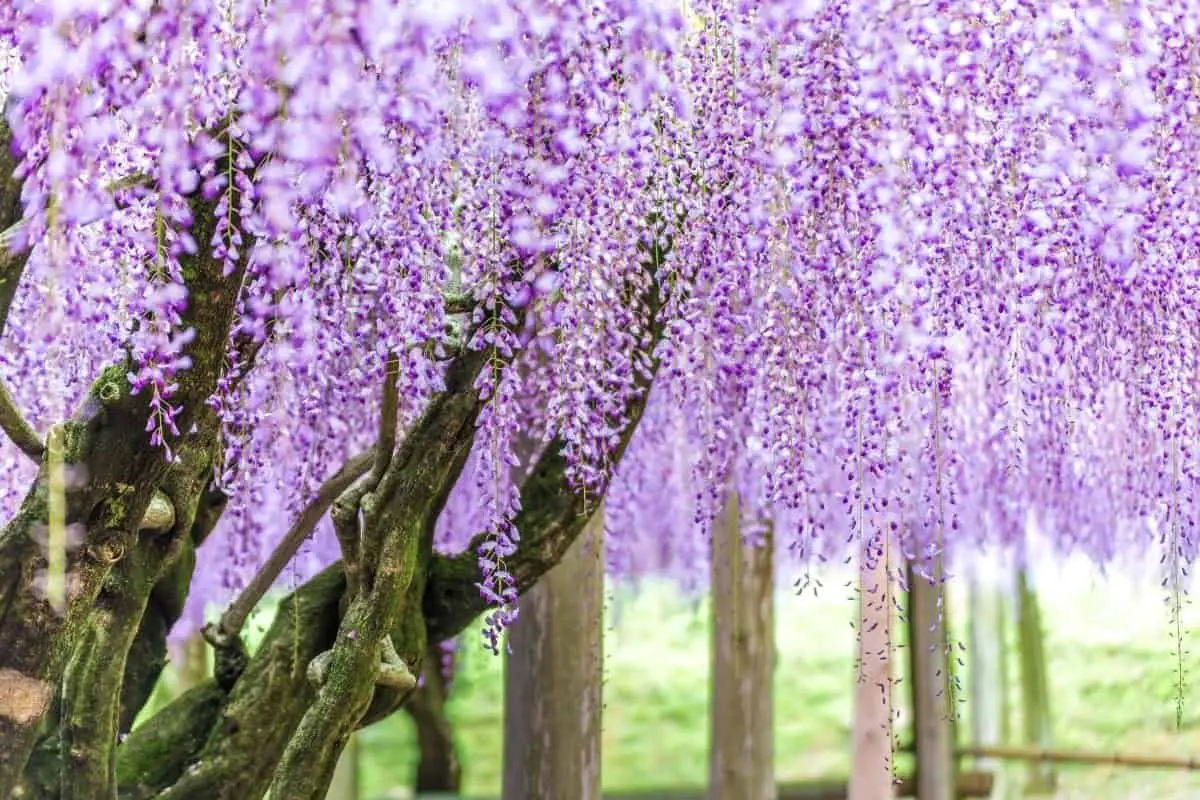Last Updated on December 14, 2021 by Cristina
Every gardener should know when to trim wisteria to keep this tree in the right state and stop it from spreading too far.
Trimming Wisteria is not as complicated as most gardeners believe. Pruning is best done twice a year in July or August and in January or February. Wisteria has a habit of growing out of control into roof spaces, behind gutters and downpipes.
Pruning ensures that this vigorous climb looks better and grows only in the allowed spaces. It also helps the plant concentrate on flowering rather than producing lots of foliage.
When Do You Trim Wisteria?
The best time to prune wisteria varies depending on your local climate and the variety of wisteria you are growing. However, it is vital to keep an eye on your wisteria plant between June and September.
Before pruning, it is essential that your wisteria has finished flowering. You are likely to perform another pruning around January or February before the start of spring.

Click Here to Learn How to Trim These Trees:
How To Trim Wisteria In Winter
Winter pruning happens in January or February, concentrating the plant’s efforts to build up flower-bearing offshoots. During this season, the plant is dormant and leafless, making it easy to see what you are cutting off and making pruning much more manageable.
Once you are done, you will be left with a clear tree with little offshoots ready to burst into flower in late spring. Pruning in this season ensures that you will not have to disturb the flowers as they bloom.
Older plants require severe pruning if all the dead branches get in the way of windows and doors. Always cut the stems to the main branch just above a young shoot.
Here are some things to consider when pruning in winter:
-
-
While pruning wisteria in winter, you will need to cut back any growth from the previous summer out of place or too long.
-
Prune the shoots back to 2 or 3 bags to help encourage a new flowering display in the following spring.
-
Remove any dead or diseased wood as well as suckers growing from the roots.
-
THANOS A1101 Extendable Anvil Loppers Tree Trimmer with Compound Action
-
-
Don’t prune any large buds as they will develop into full flowers in the month of May.
-
Remove any weak rubbing or crossing branches.
-
Winter pruning is perfect for reshaping the structure of your plant as you want it. This is significant if you grow your wisteria on a trellis or pergola.
-
Start pruning a wisteria plant once it reaches its desired height by removing 1/3 of its new growth every year. This will encourage stronger shoots with full flowers and less twig growth.
-
Remember, it’s all about controlling growth than creating an attractive shape as you prune. Therefore, it is not necessary to prune the wisteria plant to create a stunning display.
-
Trimming Wisteria In Summer
Pruning wisteria in the summer allows more light and air into the plant. It encourages the wood to ripen and prepare for new growth to develop. Wisteria is a vigorous climber, and running it at this time of the year helps keep it under control.
To avoid pruning out all the flower buds that will bloom next year, it is best to undertake summer pruning. This promotes a stronger and more manageable plant structure for your wisteria plant. It also makes the plant look much tidier and focuses on flower bud formation near the main branches of the vine.
As long as your plant has finished blooming, you can prune it anytime during summer. Here are a few things to consider when pruning in the summer.
-
-
When pruning in the summer season focus on cutting back the long leafy whippy shoots. Look around your wisteria and find any extended growth; count up to 5 buds and then clip the remainder of the stem.
-
Don’t be worried about getting too much or not enough, rather aim for an equal all-round pruning.
-
Remove any diseased or dead wood as well as any weak branches so that your tree will have more room for growth.
-
Ensure that the major branches are not crossing over each other and remove any that are causing overcrowding.
-
Check for any suckers at ground level and prune them away. Suckers look like thin branches that grow out of the main trunk or the limbs.
-
Cutting Back Wisteria
You can cut back your wisteria plant if it has a lot of dry or branches and it looks out of shape. When your tree grows old you will need to remove all the dry and old-looking branches and the leaves that touch any part of your house.
Sometimes it is necessary to cut all the branches down to the main stem or even down to the ground level as part of renovating the plant. Cutting back wisteria is known as hard pruning and gives your tree and impulse to shoot new strong branches.
Training A Wisteria
The easiest way to keep a wisteria from spreading out of control is to prune it twice a year. When your wisteria tree is not growing wildly out of control, it forms beautiful archways across your landscape or home.

Tips for training your wisteria
-
-
Ensure your structure that will hold the wisteria plant is made of sturdy material like metal or wood. Wisteria trees are known to crash flimsy supports.
-
Choose 2 to 3 young shoots to twine around each other to the pole.
-
As they grow, these twisted trunks will become a primary source of stability for your plant.
-
Tie them closely enough to the structure as they grow until they are able to support themselves; then, you can remove the twine.
-
These tips will help you successfully train your waist area to grow upright within the restriction of the study structure.
Conclusion
To trim your wisteria use hand pruners or a pair of loppers. If your branches are too tough and old, you can use a pruning saw that will help cut them with ease. Have you pruned your wisteria before, let us know how your experience was like.
Caroline is a gardener who loves to get down to the nitty–gritty of gardening. She proudly proclaims herself as a ‘dirt worshipper‘ and can often be found deep in the garden, covered in soil and singing to her plants. As a self–proclaimed ‘plant whisperer‘, Caroline believes that plants need love and attention just like any other living thing, and she loves to give them both. When she‘s not tending to her garden, you can often find her researching the latest gardening trends, or teaching others how to make their gardens thrive



